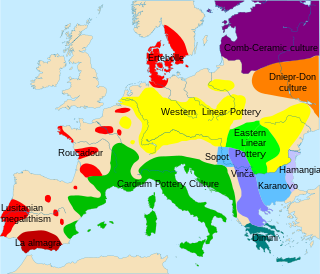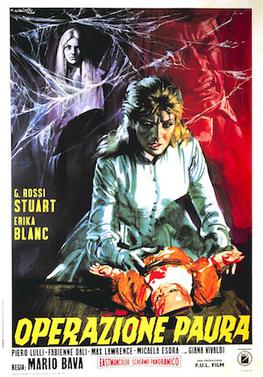
Cardium pottery or Cardial ware is a Neolithic decorative style that gets its name from the imprinting of the clay with the heart-shaped shell of the Corculum cardissa, a member of the cockle family Cardiidae. These forms of pottery are in turn used to define the Neolithic culture which produced and spread them, commonly called the "Cardial culture".

The Opening Ceremony of the 2006 Winter Olympics was held on 10 February 2006 beginning at 20:00 CET (UTC+1) at the Stadio Olimpico in Turin, Italy.

Ugo Tognazzi was an Italian actor, director, and screenwriter.
A name in the Italian language consists of a given name and a surname ; in most contexts, the given name is written before the surname, although in official documents, the surname may be written before the given name or names.

A zombie is a mythological undead corporeal revenant created through the reanimation of a corpse. In modern popular culture, zombies are most commonly found in horror genre works. The term comes from Haitian folklore, in which a zombie is a dead body reanimated through various methods, most commonly magical practices in religions like Vodou. Modern media depictions of the reanimation of the dead often do not involve magic but rather science fictional methods such as fungi, radiation, gases, diseases, plants, bacteria, viruses, etc.

Sleepless is a 2001 Italian giallo film directed by Dario Argento. The film stars Max von Sydow and Stefano Dionisi and marks Argento's return to the giallo subgenre. The film was another box office success when it opened in Italy, taking in over 5,019,733,505 lira by the end of its theatrical run.
The Boves massacre was a World War II war crime that took place on 19 September 1943 in the comune of Boves, Italy. The event took place following the Italian surrender on 8 September 1943. Twenty-three Italian civilians were killed and several hundred houses were destroyed by artillery fire of the Waffen-SS under the command of Joachim Peiper. The massacre and destruction were reprisals for one German soldier having been killed and two German NCOs having been captured and held by Italian partisans in the vicinity of the town. After obtaining their release, Peiper ordered the destruction of the town, despite earlier promising not to do so.

Kill, Baby, Kill is a 1966 Italian gothic horror film directed by Mario Bava and starring Giacomo Rossi Stuart and Erika Blanc. Written by Bava, Romano Migliorini, and Roberto Natale, the film focuses on a small Carpathian village in the early 1900s that is being terrorized by the ghost of a murderous young girl.
Specializing in the field of drama, with particular attention to the drama of its national heritage, the Accademia Nazionale di Arte Drammatica Silvio D'Amico has played a key role in the Italian film and theater scene and is currently headed by Professor Luigi Maria Musati. It has prepared artists such as Margherita Buy, Vittorio Gassman, Luigi Lo Cascio, Anna Magnani, Nino Manfredi, and Monica Vitti. Other former alumni include Antoniano, Manuela Arcuri, Mino Bellei, Carmelo Bene, Dirk van den Berg, Giuliana Berlinguer, Alessio Boni, Alberto Bonucci, Giulio Bosetti, Renato De Carmine, Ennio Fantastichini, Gabriele Ferzetti (expelled), Scilla Gabel, Domiziana Giordano, Michele Placido, Luca Ronconi, Gian Maria Volonté and Lina Wertmüller.

Salvatore Leopoldo "Leo" Gullotta is an Italian actor, voice actor, comedian and writer. He became known for his role in Café Express (1980), and has won several David di Donatello awards, the first one being for his role in Giuseppe Tornatore's The Professor (1986).
The filmography on immigration in Italy is a phenomenon started with the arrival of the first migratory flows in Italy, since the 1990s.

The Italian photographer Gianni Berengo Gardin has been the sole contributor or a major contributor to a large number of photobooks from 1960 to the present.

People and Religions – Terni Film Festival is an international film festival, which takes place annually in November at the CityPlex Politeama Lucioli in Terni and at many other venues around the town. It deals with interfaith dialogue, spirituality in cinema, immigrant integration, visual education and activities for prisoners. For two consecutive years, the festival was awarded the Medal of the President of the Italian Republic. It has been organized by ISTESS, Institute of Theological and Historical-Social Studies, directed by Stefania Parisi. Honorary president of the festival is Krzysztof Zanussi, Polish film director; the artistic director is Arnaldo Casali. Promoted by the diocese of Terni Narni Amelia and by the Episcopal Conference of Umbria, the festival enjoys the patronage of the Municipality of Terni and the Pontifical Council for Culture, with the support of the Umbria Region, the Ministry of Cultural Heritage and Activities, as well as the Fondazione Cassa di Risparmio di Terni e Narni.

Suburra: Blood on Rome is an Italian crime drama television series set in Rome. It is based on the 2015 film Suburra, in turn inspired by the novel of the same name by Giancarlo De Cataldo and Carlo Bonini. The series was initially released and intended as a prequel to the 2015 film during its first two seasons, but it changed direction in its final season, following Rai Fiction’s departure from the project, to become a separate, divergent adaptation. The series was developed by Daniele Cesarano, Barbara Petronio, Ezio Abbate and Fabrizio Bettelli for Netflix, making it its first Italian-language original television series. The show premiered on 6 October 2017 and ran for three seasons totaling 24 episodes until 30 October 2020. It was produced by Cattleya in association with Rai Fiction and Bartleby Film. Rai Fiction was not involved in the production of the third and final season.

The history of horror films was described by author Siegbert Solomon Prawer as difficult to read as a linear historical path, with the genre changing throughout the decades, based on the state of cinema, audience tastes and contemporary world events.

La porta rossa is an Italian noir television series created by Carlo Lucarelli and Giampiero Rigosi for Rai Fiction. It premiered on Rai 2 on February 22, 2017 and concluded on February 1, 2023, having aired 32 episodes over three seasons.












